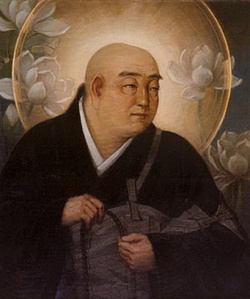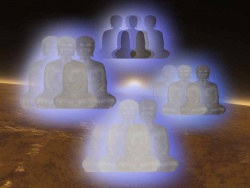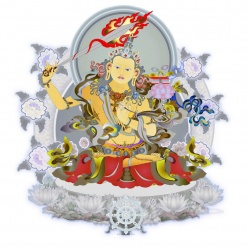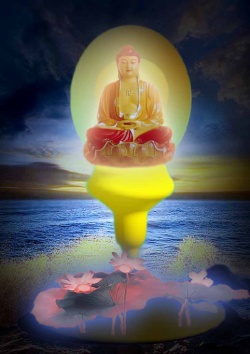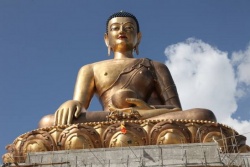Kings of Brightness in Japanese Esoteric Buddhist Art
Kings of Brightness, or Myōō, are among the Buddhist deities imported from China to Japan as part of the pantheon of Esoteric Buddhism in the early ninth century.
Wrathful in countenance, the Kings of Brightness are staunch protectors of the Buddhist Law, as well as masters of channeling unruly passions toward constructive ends.
Due in part to its inclusion of powerful beings like the Kings of Brightness, Esoteric Buddhism was perceived to offer spiritual and worldly benefits beyond those offered by other forms of Buddhism theretofore practiced in Japan, and it thus transformed the arts and rituals of Japanese Buddhism.
In particular, it exerted a profound influence on the Buddhism practiced within court circles as it developed over the course of the Heian period (794–1185).
Images of the Kings of Brightness continue to be venerated in the Esoteric rituals of Japan's Tendai and Shingon schools of Buddhism, but Fudō Myōō, in particular, enjoys cross-sectarian popularity.
Fudō Myōō, the "Immovable" King of Brightness, is considered to be a direct emanation of the Buddha Dainichi Nyorai, who is the principal Buddha of Esoteric Buddhism (26.118) and appears at the center of the main mandalas of the tradition.
The most widely represented of the Kings in Japan, sculptures of Fudō Myōō are often housed in temple halls called Gomadō where a fire-burning ritual called the goma-e is performed (1975.268.163).
The ritual involves the burning of talismans and other possessions to symbolically destroy defilements.
An early eighth-century commentary on the Buddhist scripture, the Dainichi Sutra, is the basis for the iconography of many images of Fudō:
"His figure is like a child. In his right hand he holds the great sword of wisdom and in his left hand he holds the lasso. On the head there is a pile of hair and hair hangs down his left shoulder.
The left eye is slightly closed and the lower teeth bite the upper lip at the right side. The lower left lip protrudes. On the forehead are grooves like waves.
He sits on a rock.
He looks humble and fat. He is extremely angry." Emphasizing his role as an unflagging, fierce defender of Buddhism, Fudō uses his sword to cut through ignorance and his lasso to reign in those who would block the path to enlightenment.
He is often accompanied by two attendant youths (dōji) named Kongara and Seitaka (1975.268.26-.28), but is sometimes shown with larger groups of youths (67.55.38).
In Japan's medieval era, his image was favored by samurai, who saw in his fierce aspect and calm, observant demeanor a model for their own actions (14.100.121).
After Fudō, Aizen Myōō is the most often encountered King of Brightness in Japanese Buddhism (66.90). Like Fudō and the other Kings, Aizen was appropriated by Buddhists from Hinduism.
He is always bright red, and in two of his six arms he holds a bow and arrow, properties borrowed from Kāma, the Hindu god of love (1975.409.3). Aizen's role is to convert carnality into aspiration for enlightenment, but people also turn to him for assistance with matters of the heart.
Aside from paintings and sculptures that present certain Kings individually, the Kings of Brightness referred to as the Five Great Kings of Brightness (Five Kings) are often portrayed as a group—sometimes as sets of paintings and sculptures, and sometimes painted within a single scroll.
The five are described in the scripture Benevolent Kings Sutra, a text aimed at encouraging rulers to uphold the Buddhist Law.
The group includes Fudō, Gōzanze Myōō, Gundari Myōō, Daiitoku Myōō, and Kongōyasha Myōō (1975.268.12; 1975.268.13).
Paintings of the group were often used in the Heian period for an imperial court–sponsored ritual centered on the Benevolent Kings Sutra.
At the ritual, the special powers of the Kings were called upon to protect the nation. For example, Daiitoku Myōō's Sanskrit name, Yamāntaka, means, "one who stops the power of the King of Hell," or the one who terminates death.
In Japan, Daiitoku has often been portrayed riding a bull he has subdued, but in China and Tibet, he can be found with the head of a bull (1992.54).
Beyond state rituals, prominent members of court society also commissioned mandala-driven rituals for their personal needs and worldly aspirations, from protection against diseases to success in competition with political rivals.
These frequently included images of Myōō.
Japanese monks returning from travel and study in China brought back multiple scriptures, commentaries, and iconographic guides to Esoteric Buddhist deities, as well as fully realized painted mandalas and ritual implements adorned with the corporal forms of Buddhist deities including the Kings of Brightness (Tang dynasty bell with Myōō ).
As part of the process of parsing and synthesizing the new information, Japanese monastic communities both copied and created annotated iconographic guides. The eighth of a ten-scroll encyclopedic text known as Collected Iconography (Zuzōshō) and designed to help monks navigate proliferating iconographic and ritual variations was dedicated to the Kings of Brightness.
The early twelfth-century original is lost, but a number of early copies survive.
A lightly colored version in ink on paper dating to the late twelfth to early thirteenth century and said to have belonged to the major Esoteric Buddhist temple Tōji in Kyoto reveals the wrathful qualities of the Kings, with their grimacing facial expressions and the extreme flames of their mandorlas (1975.268.6).
The surrounding texts explain how the deities should look, what they hold in their hands, their aliases, and the textual bases in Buddhist scripture for the descriptions.
The iconography for the Kings of Brightness expanded beyond its intended use to provide models for figural representations of certain deities originating in the Japanese tradition of kami veneration and later incorporated into Shinto-Buddhist combinatory schemes of worship.
Notable among these examples is the iconography for the deity Zaō Gongen (1975.268.155).
Zaō Gongen is a name given in Shinto-Buddhist combinatory thought to a kami residing on Mount Kinpu.
In the cult of Shugendō, a Buddhist tradition based in austere practices carried out deep in the mountains, Zaō is seen as a manifestation of the Buddha Shakyamuni and the Buddha Miroku—the Buddha of the Future.
While the representation of Zaō was a completely new invention based on Buddhist iconographical prototypes, other kami became identified with particular Kings of Brightness, and appear in their Buddhist forms in mandalas devoted to specific sites of kami worship, such as Mount Kumano (2006.521).
The collection of The Metropolitan Museum of Art contains for the most part examples of representations of Kings of Brightness dating from the Heian period through the Edo period (1615–1868), in painted and sculpted form, that would have been used in temples, as well as metalwork incorporated into armor.
A small number of images of Fudō Myōō associated with the ukiyo-e tradition (2005.350a-c; JP1251) reveal the deity's presentation in popular theatrical productions and literature.
One example, however, speaks to the Museum's position as an international crossroads for the arts and the larger-than-life personalities passing through the metropolis of New York;
at the turn of the twentieth century, a grand champion (yokozuna) sumo wrestler by the name of Hitachiyama Taniemon (1874–1922) presented the Museum with his wrestling costume, a photograph of himself wearing it (08.25.5), and a personal devotional icon of Fudō Myōō, the exemplar of righteous strength, in a small shrine (08.74).
Sinéad Vilbar Department of Asian Art, The Metropolitan Museum of Art
Citation
Vilbar, Sinéad. "Kings of Brightness in Japanese Esoteric Buddhist Art". In Heilbrunn Timeline of Art History. New York: The Metropolitan Museum of Art, 2000–. http://www.metmuseum.org/toah/hd/kibr/hd_kibr.htm (October 2013)
Further Reading
Goepper, Roger. Aizen-myÅÅ, the Esoteric King of Lust: An Iconological Study. Zurich: Artibus Asiae, 1993. Gerstle, Andrew C., "Flowers of Edo: Eighteenth-Century Kabuki and Its Patrons." Asian Theater Journal 4, no. 1 (Spring 1987), pp. 52–75. MyÅÅ: Buddhist Deities of Wrath and Love. Nara: Nara National Museum, 2000.
Okada, Barbra Teri, in collaboration with Kanya Tsujimoto. "The FudÅ MyÅ-Å from the Packard Collection: A Study during Restoration." Metropolitan Museum Journal, no. 14 (1980), pp. 51–66.
These related Museum Bulletin or Journal articles may or may not represent the most current scholarship. Okada, Barbra Teri and Tsujimoto, Kanya. "The Fudo Myo-o from the Packard Collection: A Study during Restoration". Metropolitan Museum Journal, Vol. 14 (1979) JSTOR | PDF
